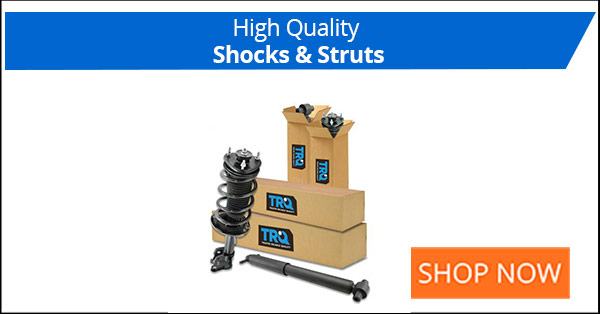Bad Shocks & Struts Symptoms
Your shocks and struts can wear over time. The rate of wear will depend on the driving conditions where you live, but generally shocks and struts last about 50,000 to 80,000 miles. Shocks and struts are important to the overall safety of your vehicle. They help keep the tires in contact with the road, giving you the traction to accelerate, stop, and steer as necessary. They also keep your ride smooth and in control. To learn about the different between shocks and struts, read here.
Symptoms of Bad Shocks or Struts
It’s pretty easy to check if shocks and struts need to be replaced. There are some telltale signs and symptoms that your shocks and struts may be wearing out, some visual signs to look for, and a simple test you can do yourself to decide if you need to replace them.
- Your ride will start to feel rougher or more bouncy than before.
- You may hear a rattling or creaking sound when you drive over bumps.
- Brake dive, acceleration squat, and the body roll.
- Loss of traction and increased stopping distances
- Uneven tire wear, including cupped indentations or bald spots
There are a few early warning signs that might tell you it’s time to check your shocks or struts. First, you might notice that your ride is rougher or more bouncy than before. That’s because the job of the shock absorber is to even out the bounce from your springs. You also might notice a rattling or creaking sound when you drive over bumps.
Brake dive is when the nose of your car dips low under hard braking conditions. Acceleration squat is just the opposite – the rear end dips when you hit the gas. Either one of these conditions is a sign that your shocks or struts aren’t doing a good job of reacting to weight transfer of your car. A similar effect is known as body roll. That’s when the body of the car dips to one side during a turn. Again, it’s a symptom of weak shocks that aren’t providing enough resistance to weight transfer.
Because your shocks and struts also help keep your tire pressed to the road, bad shocks and struts can cause a loss of traction. You might experience this problem as increased stopping distance from your brakes or poor steering control. The bouncy ride of a bad shock or strut might also cause the tire to bounce down the road, leading to uneven tire wear. A pattern of cupped or feathery indentations or bald spots on your tires can be a symptom of a shock problem.

How to Inspect Your Shocks and Struts
If you’re experiencing any of the above signs, you’ll want to visually inspect your shocks or struts. To do that, you’ll inspect the shock’s structure and surface, check for leaks, and check the mounts and bushings.
First look at the shocks themselves. Check to see if the shocks are bent. Then look for dents or holes in the surface of the shock. If your shocks exhibit either of these signs, they’ll need to be replaced.
Next, you’ll want to check for leaks. Shocks are filled with hydraulic fluid – basically oil. It’s actually normal for a little oil to seep out over time, which over tens of thousands of miles contributes to standard wear and tear. If, on the other hand, you have a lot of oil leaking out of the shock, there may be a broken seal, and you’ll need to replace your shocks right away. This video shows an example of a strut with a serious leak:
You should also check the points where your shocks or struts connect to the frame and to the axle and wheel. Look for torn or loose bushings or loose mounts or studs. Any of these problems is a sign of a bad strut.
How to Test Your Shocks or Struts
If your shocks or struts aren’t exhibiting visible problems, they still may simply be worn out. Luckily it’s pretty easy to test if your shocks or struts are bad. The test is known as the bounce test or sometimes the bounce and jounce test.
Just walk to one corner of your car and push down hard on the hood, trunk, or fender at that corner. The car should bounce back once and then hold steady at ride height. If it bounces one and a half times, your shocks are probably still fine. If it keeps bouncing, then your shocks are too weak to counteract the movement of your springs, leading to the bouncing tire effect mentioned above.
Test all four corners. Whichever corner or corners bounce need new shocks. That being said, we recommend replacing shocks in sets. If you have a new shock and an old one across from it, you might end up with an uneven ride height.
Replacing Your Own Shocks or Struts
Replacing shocks or struts can be a very involved job, but it is possible for DIYers to replace their own shocks. You’ll have to raise and support the corer you’re working on and remove the wheel. Then remove any suspension parts you need to in order to reach the shock.
If you’re replacing a strut, you’ll also want to support the wheel knuckle. Then remove the bolts that connect the shock or strut to the frame and to the axle or wheel knuckle, and remove the shock or strut. You can then reverse the process to install the new shock. You should get a professional alignment done any time you work on any steering or suspension parts, including your shocks and struts.


